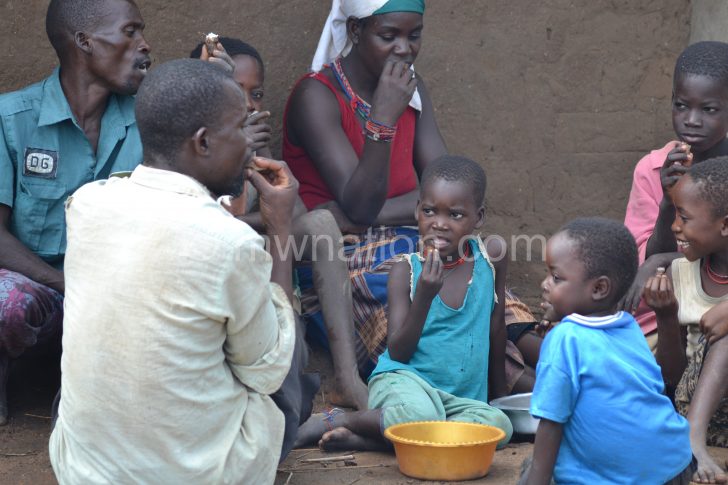From dozens of people queuing up for food aid at Kapili on the fringes of Nkhotakota District, emerges a seemingly fatigue-laden woman balancing a bag of maize on her head.
Wearing a wrinkled face that is heavily soaked with sweat, the woman Hawa Malithani takes a deep breath as she finally breaks away from the crowd.
A family shares a meal: Many Malawians face hunger this year
“I have been waiting for hours to collect my share. I am relieved I finally got it,” she says, her trembling hands tightly holding onto the bag, her most prized asset, for now.
Malithani, who is in her mid-70s, confesses that hunger has been prevalent in her household, leading her to sometimes sleep on an empty stomach.
She explains: “I rarely have enough food especially during the lean period. On my worst days, I survive on one meal a day that comes from the flour I get paid after doing some piecework.”
The food support Malithani has just received is part of the nationwide initiative through which the Department of Disaster Management Affairs has been distributing maize to millions of Malawians over the years.
Identification of the beneficiaries is done through the Malawi Vulnerability Assessment Committee (Mvac) which annually compiles reports detailing out the number of people in need of food aid.
Nation on Sunday through analysis of those annual reports in the past decade (2011-2021)has established that food insecurity has worsened in the past five years despite heavy investments in farm input subsidies.
In the period under review, Nation on Sunday found that in the years leading up to 2013 Malawians facing food insecurity averaged 1.2 million annually.
In 2014, the figure drastically dropped as Mvac established that those in need of food aid were around 600 000 and in 2015, that figure remained almost the same.
Past the first half of the period under review, the food situation began deteriorating. Mvac’s assessment for 2016 showed that 6.5 million people were food insecure.
The following year, the number dropped to slightly above one million. That, however, was still way above the 600 000-mark recorded in 2015.
In 2018, about 3.3 million Malawians were food insecure, 1.8 million in 2019, and 2.6 million in 2020 and 1.6 million in 2021 assessment.
The food insecurity has been worsening despite that government has been investing heavily in farm input subsidies averaging K142 billion annually.
However, Ministry of Agriculture spokesperson Gracian Lungu said some people facing food insecurity are not beneficiaries of the Affordable Inputs Programme (AIP), a flagship initiative that provides cheap fertilisers and seeds to around 3.7 million smallholder farming households.
He said: “The Mvac report takes into consideration all manner of people including those in town who are not farmers and do not have financial resources to buy food. That’s why you observed that some months ago maize was being distributed in Lilongwe townships.
“We cannot, therefore, be blaming AIP for the situation. Previously, the subsidy programmes were marred by corruption; hence, it was not effective.
“When the new government came in, you can see that the food insecurity statistics have decreased in the past two years. This shows that AIP is being managed in an effective way.”
Lungu said the ministry has devised an irrigation strategy which requires about K18 billion to roll out. He hyped it as a catalyst to improve irrigation farming and reduce food insecurity.
He said: “We know that irrigation farming cannot produce much but it still helps to supplement what we produce through rain-fed agriculture.
“To improve the sector, we are trying to replace Escom electricity which has proved to be expensive in pumping water for irrigation schemes. Increasing irrigation agriculture production capacity will also help reduce the levels of food insecurity in the country.”
The government has been investing significantly in food aid to cushion the vulnerable families. In the 2021/22, K7.94 billion was allocated for the initiative.
The Mvac report projected that the 1.6 million people would require 35 296 metric tonnes of maize during the lean period which runs from December to March.
In the reaction, agriculture economist Wisdom Mgomezulu has attributed the food insecurity to climate change the country continues to face.
“The country has faced a combination of floods, droughts, rising input prices and pests and diseases including fall army worms which have resulted in crop failure. As such, food aid has been the order of the day in solving hunger problems in the country
“Secondly, the over-dependence on smallholder agriculture resulting from limited sources of incomes imply that smallholder farmers are quick to sell their output at low prices in order to meet other obligations like school fees and so forth,” said the Daeyang University acting research director.
The post Food insecurity worsens in past five years appeared first on The Nation Online.
 Moni Malawi
Moni Malawi 

